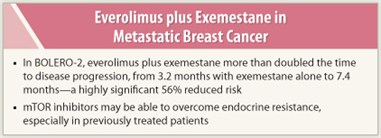 Adding an inhibitor of mammalian target of rapamycin (mTOR) to an aromatase inhibitor more than doubled the time to disease progression in patients with advanced, treatment-refractory breast cancer in the phase III BOLERO-2 trial, whose updated results were presented at the San Antonio Breast Cancer Symposium by Gabriel Hortobagyi, MD, of The University of Texas MD Anderson Cancer Center, Houston.1
Adding an inhibitor of mammalian target of rapamycin (mTOR) to an aromatase inhibitor more than doubled the time to disease progression in patients with advanced, treatment-refractory breast cancer in the phase III BOLERO-2 trial, whose updated results were presented at the San Antonio Breast Cancer Symposium by Gabriel Hortobagyi, MD, of The University of Texas MD Anderson Cancer Center, Houston.1
“We believe these results underline the fact that everolimus [Afinitor] is the first agent to significantly enhance the efficacy of hormonal therapy in patients with estrogen receptor (ER)-positive, HER2-negative advanced breast cancer, and could represent a paradigm shift in the management of this patient population,” Dr. Hortobagyi predicted.
Virtually all patients with ER-positive advanced disease develop resistance to hormonal therapies, and finding a means of overcoming this resistance is the subject of strong research efforts. Resistance to hormonal therapy in breast cancer has been associated with overactivation of the mTOR pathway, and by targeting mTOR, everolimus interferes with tumor cell proliferation, angiogenesis, and cell metabolism.
“Everolimus is the first treatment to significantly enhance the efficacy of hormonal therapy in this patient population, where this remains a significant unmet need,” Dr. Hortobagyi noted.
Details of Updated Analysis
Treatment with everolimus plus hormonal therapy more than doubled progression-free survival, from 3.2 months with exemestane alone to 7.4 months, representing a highly statistically significant 56% reduction in the risk of progression (P < 1×10 -16). While this analysis was done with local tumor assessment, another assessment by central independent review found even greater benefit, with progression-free survival of 11.0 months vs 4.1 months, a 64% risk reduction (P < 1×10 -16), Dr. Hortobagyi reported.
In remarking on the robustness of the findings at a media briefing, Dr. Hortobagyi noted that the prolongation of progression far exceeded the investigators’ expectations. “The study demonstrated not a 26% reduction in progression, as we had expected, but a 56% reduction in events, with a P value for which I don’t have enough fingers to count.”
Disease-free survival rates at 1 year were 31% with the combination vs 10% with exemestane alone. As of December 2011, deaths had occurred in 23.1% and 29.3%, respectively.
Side effects were consistent with those previously reported with everolimus. The most common grade 3 or 4 adverse events were stomatitis, anemia, hyperglycemia, dyspnea, fatigue, and pneumonitis, all occurring in < 10% of patients receiving the combination. The addition of everolimus did not negatively impact quality of life. ■
Disclosure: Dr. Hortobagyi serves as a compensated consultant to Novartis and receives funding as a participant in a clinical trial based on zoledronic acid, also a Novartis drug.
Expert Point of View: Everolimus plus Exemestane Significantly Prolongs Remission in BOLERO-2
Reference
1. Hortobagyi GN, Piccart M, Rugo H, et al: Everolimus for postmenopausal women with advanced breast cancer: Updated results of the BOLERO-2 phase III trial. 2011 San Antonio Breast Cancer Symposium. Abstract S3-7. Presented December 8, 2011.

 Signaling of mammalian target of rapamycin (mTOR) is required for estrogen-induced breast tumor cell proliferation, and hyperactivation of the mTOR pathway is observed in endocrine-resistant breast cancer cells. Clinically, this makes for a rational one-two punch in endocrine-resistant breast...
Signaling of mammalian target of rapamycin (mTOR) is required for estrogen-induced breast tumor cell proliferation, and hyperactivation of the mTOR pathway is observed in endocrine-resistant breast cancer cells. Clinically, this makes for a rational one-two punch in endocrine-resistant breast...